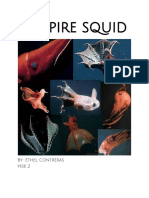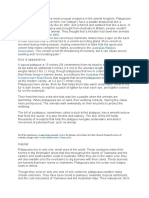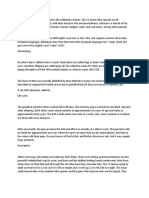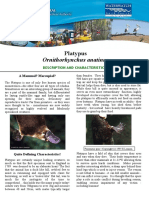Amazon Abyss
Amazon Abyss
Uploaded by
Syahida IryaniCopyright:
Available Formats
Amazon Abyss
Amazon Abyss
Uploaded by
Syahida IryaniOriginal Description:
Copyright
Available Formats
Share this document
Did you find this document useful?
Is this content inappropriate?
Copyright:
Available Formats
Amazon Abyss
Amazon Abyss
Uploaded by
Syahida IryaniCopyright:
Available Formats
Amazon Abyss
Join Mike de Gruy, Kate Humble and an international team of scientists and divers in
search of some of the Amazon's most incredible creatures.
First shown April 2005 on BBC One.
The awesome Amazon is wider and deeper at
some points than the English Channel, flowing
6,500km across South America.
It's famous for the surrounding rainforest, which
can take visitors by surprise because it is not all
thick tropical jungle. Watch what dive
cameraman, Mike de Gruy, thought after his
first trip to the river for the Amazon Abyss
expedition.
RealPlayer is needed to view this video. Download it free.
Amazon creatures
The waters too are home to incredible creatures. Here are some of the most amazing
featured in the programmes.
Giant otter Pteronura brasiliensis
The Amazon's rarest large mammal now lives only in the most remote parts of the
region.
It's an intelligent, social animal and at 1.8m long when fully grown, is one of the top
predators of the region's freshwater fish. Partial to shellfish and crabs, the giant otter
carries a favourite rock around to help it break open shells.
The world's biggest species of otter faces very high risk of extinction, according to the
World Conservation Union (the IUCN). No longer hunted for its fur, the giant otter's
survival now depends on protection of the areas in which it lives from destruction and
pollution.
More about the giant otter in Wildfacts or watch video on the external ARKive site.
Back to top
Boto (Amazon river dolphin)
Inia geoffrensis
This is the largest species of freshwater dolphin.
Some people think the boto can stun prey with
a burst of sound, produced in its distinctively
bulbous forehead.
The dolphin's body colour changes through its
lifetime. Beginning dark grey, it turns pale or
vivid pink before fading almost to white.
The neck bones are more flexible than in most other dolphins, so it can move its head
independently of its body. This helps with echolocation in the murky Amazon waters.
Other adaptations for river life include sharp hearing and a long beak. Distinctive
whisker-like hairs around the mouth aid foraging for food in mud.
More about the boto in Wildfacts or watch video on the external ARKive site.
Back to top
Green anaconda Eunectus marinus
This is the world's largest snake and can grow
to 10m long and 130kg in weight.
It hunts birds, reptiles and mammals in and out
of water. The snake coils around its prey,
crushing it until it can no longer breathe. There
are reports of anacondas eating people. The
anaconda doesn't need to feed very often
though perhaps not for three months after a
sizeable kill.
Unusually for a snake, the anaconda does not lay eggs; females give birth to live young.
It is not officially registered as threatened, but it is protected by CITES, the Convention
on International Trade in Endangered Species.
Back to top
Catfish
Thirty-four varieties of catfish make up the Siluriformes order of ray-finned fish. The
Amazon is home to incredible catfish with specialisms to help them survive the tough
conditions.
Wood eating
Panaque fish have spoon-shaped teeth which they use to rasp at submerged wood.
Bacteria in their guts convert plant cellulose into nutritious chemicals.
Air breathing
The water in slow-moving parts of the Amazon river system is often low in the dissolved
oxygen that fish need. Some types of catfish supplement the oxygen their gills absorb
by swallowing air and breathing with their intestines.
Land living
The phraetobius catfish has taken air-breathing
to an extreme. It lives out of water, in the leaf
litter on stream banks. Blood vessels all over its
skin mean its entire body is capable of gaseous
exchange. It has no eyes and uses touch to
detect its insect prey.
Fisherman frightening
The ja (Paulicea lutkeni) is notorious among
native people. It grows to 1.5m and can weigh
over 100kg. Immense strength gives rise to its
reputation for dragging fishermen down into the depths.
Back to top
Electric fish
In the murky river waters of the Amazon basin, sight and smell can be of limited value.
Some fish have turned to using electricity instead.
Navigation
The blind tubesnout lives in deep water, 30m or so down. It uses low voltages to sense
its surroundings.
Communication
Finding a mate is made easier for the glass knifefish, Gymnotus rosamaria, by its ability
to send electrical advertisements to potential partners. At 3045cm in length when fully
grown, the long, thin shape and transparency of this fish is reflected in its name.
Weaponry
The electric eel, Electrophorus electricus, is not a true eel: it has no teeth and doesn't
migrate out to sea. It uses electric fields of up to 500 volts to kill prey. Up to 2.5m long
and 35kg in weight, the eel breathes air, as the waters it lives in are often low in
oxygen.
Back to top
Bloodsucking fish
Candirus are parasitic fish known to feed on
other fish and mammals. Read more and take
part in an online vote.
Find out more in Wildfacts
The Science & Nature Wildfacts database has more information about other creatures
in the Amazon Abyss series:
Capybara
Piranha
Stingray
A name for this bloodsucking fish
The Amazon Abyss expedition discovered this brand new species. Watch the moment it
was found.
RealPlayer is needed to view this video. Download it free.
The 'vampire' fish is a smaller relative of a notorious fish called the candiru. Some of the
candiru's habits are enough to make almost anyone squirm (see "Don't go in the water"
below).
The new fish is about 25mm long and feeds off larger fish by swimming into their gill
slits and sucking their blood.
One of the expedition scientists, Mrio de Pinna
from the University of So Paulo, came up with
five suggestions for its scientific name. He
offered readers of this website the chance to
vote for their favourite.
Paracanthopoma draculae
This name is homage to Bram Stoker's fictional
vampire, Dracula.
Paracanthopoma irritans
'Irritans' is part of the scientific name for the
human flea. Fish probably find this little parasite
equally annoying.
Paracanthopoma minuta
This suggested name reflects the fact that the
new fish is a small member of the family.
Paracanthopoma nosferatu
One of the earliest film adaptations of the Dracula story is Friederich Murnau's silent
1922 version, Nosferatu.
Paracanthopoma vampyra
If you can't decide which vampire you prefer, you could hedge your bets.
Over 10,000 votes were cast. The winning name was Paracanthopoma vampyra.
Back to top
How species are named
The naming conventions for plants, animals and bacteria have been established
gradually since the 16th century.
Don't go in the water
The candiru feeds parasitically by
burrowing into body orifices then
drinking the blood of its victim.
It detects urine in the water to find
a host.
It can lodge itself in the urethra, the
tube inside the penis.
Barbs along its sides jam it in place.
Removing one without surgery is
almost impossible.
The modern binomial system uses a pair of names to describe an organism by its
species and its genus (group).
It is often credited to the 18th century Swedish scientist Carl von Linn but Casper
Bauhin, a botanist working in Switzerland, first used this approach in 1623.
Linn (also known as Carolus Linnaeus, perhaps because of his fondness for using Latin
words) did formalise the technique. His 1758 publication Systema Naturae is accepted
the world over as the basis for all modern species names.
What name you are able to give a newly-discovered animal is now ultimately decided by
the International Commission on Zoological Nomenclature.
Red piranha
Serrasalmus nattereri
Statistics
Length: 8-24cm
Physical description
Piranhas' physical characteristics, including colour, vary with location, population, and age. Generally
piranhas are reddish-orange ventrally and silver-grey-green dorsally with a black dorsal fin, black anal
fin, and reddish-orange pectoral fins. The Piranhas deep head has short, powerful jaws with triangular,
interlocking, razor sharp teeth.
Distribution
Piranhas are found in the rivers of South America.
Habitat
Piranhas are typically found in white-water streams.
Diet
Foraging methods vary in the different life stages of Piranhas. During the day, smaller fish typically
search for food whilst at dawn, late afternoon, and early evening the larger fish search for food.
Piranhas have a wide variety of food in their diet, including fins, scales, fish, insects, snails, and plants.
Behaviour
Piranha groups feed communally. Feeding frenzies will be triggered when there is a shortage of food
or blood in the water.
Reproduction
The breeding environments of piranhas tend to be main bodies of water such as lagoons. Piranhas will
change colour during spawning with the red belly getting more intense and the whole piranha
becoming slightly lighter. The pair will defend their spawning territory and prepare a nest not unlike the
breeding behaviour of birds. The female lays clusters of eggs into a bowl shaped nest created in the
sediment. These are around 4 or 5cm in depth and 15cm in diameter. The eggs will then be fertilised
by the male. The eggs hatch after two to three days, depending on the temperature of the water. The
breeders protect both the eggs and their brood. Females are most fertile during the rainy season in
April and May.
You might also like
- A Wild Child's Guide to Endangered AnimalsFrom EverandA Wild Child's Guide to Endangered AnimalsRating: 5 out of 5 stars5/5 (15)
- Psychedelics in The Age of Intelligent Machines, Terence MackennaDocument14 pagesPsychedelics in The Age of Intelligent Machines, Terence MackennaratnatanitaNo ratings yet
- Travel Under The SeaDocument18 pagesTravel Under The SeaLavinia ComanNo ratings yet
- Travel Under The SeaDocument18 pagesTravel Under The SeaLavinia ComanNo ratings yet
- The 20 Weird Animals YouDocument3 pagesThe 20 Weird Animals YouDanie AlonzoNo ratings yet
- Wildlife Fact File - Fish - Pgs. 1-10Document20 pagesWildlife Fact File - Fish - Pgs. 1-10ClearMind84100% (2)
- Vampire SquidDocument8 pagesVampire Squidapi-329501044No ratings yet
- My First Book about the Alphabet of Freshwater Animals: Amazing Animal Books - Children's Picture BooksFrom EverandMy First Book about the Alphabet of Freshwater Animals: Amazing Animal Books - Children's Picture BooksNo ratings yet
- Life in The SeaDocument9 pagesLife in The Seaemary25No ratings yet
- 40 Bizarre Creatures That Actually Exist On Earth: Share TwitterDocument37 pages40 Bizarre Creatures That Actually Exist On Earth: Share TwitterIndra100% (1)
- Sea SpeciesDocument8 pagesSea SpeciesDharmendra Singh LagoriyaNo ratings yet
- Geographic ADocument5 pagesGeographic Alyndi beyersNo ratings yet
- Size & AppearanceDocument3 pagesSize & AppearanceAndi AldiNo ratings yet
- Amphibians - Advanced: Amphibians Nature General Conference See Also Skill Level 1 Year of Introduction: 1945Document15 pagesAmphibians - Advanced: Amphibians Nature General Conference See Also Skill Level 1 Year of Introduction: 1945Jun Siguenza AmbrocioNo ratings yet
- Name: Alvear Samantha Year Basic: Third C Topic: Lion Fish Definition Group: 1Document25 pagesName: Alvear Samantha Year Basic: Third C Topic: Lion Fish Definition Group: 1Priscila Aguilar AvellánNo ratings yet
- My First Book about the Alphabet of Coral Reef Animals Volume II: Amazing Animal Books - Children's Picture BooksFrom EverandMy First Book about the Alphabet of Coral Reef Animals Volume II: Amazing Animal Books - Children's Picture BooksNo ratings yet
- OTTERSDocument6 pagesOTTERSMiguel LleraNo ratings yet
- Real Life Sea MonstersDocument26 pagesReal Life Sea MonstersVaibhav BatraNo ratings yet
- Animalia 2Document63 pagesAnimalia 2Rida IshanurNo ratings yet
- AnimalsDocument14 pagesAnimalsapi-276208698No ratings yet
- Platypus PDFDocument2 pagesPlatypus PDFRaajeswaran BaskaranNo ratings yet
- The Platypus (Ornithorhynchus Anatinus)Document3 pagesThe Platypus (Ornithorhynchus Anatinus)Toàn LêNo ratings yet
- No Es Un Castor, No Es Una Nutria y Tampoco Es Un Pato Aunque Tenga Partes de Una Caricatura para NiñoDocument3 pagesNo Es Un Castor, No Es Una Nutria y Tampoco Es Un Pato Aunque Tenga Partes de Una Caricatura para NiñoJUAN GALLEGO TACHACKNo ratings yet
- Amphibians 3Document6 pagesAmphibians 3Glenn GanganNo ratings yet
- Frogs vs. Toads: CaeciliansDocument2 pagesFrogs vs. Toads: CaeciliansZonny Zivins PresentsNo ratings yet
- 5 Types of Fish Often Called As The 'Dragon Fish' by Eka RahmadhyDocument3 pages5 Types of Fish Often Called As The 'Dragon Fish' by Eka RahmadhyMpiezNo ratings yet
- ProjectDocument5 pagesProjectAbid ShaikhNo ratings yet
- Crețu Ovidiu Sava Silviu-Alexandru Petrescu Alex - Dumitru Cârjă CristianDocument15 pagesCrețu Ovidiu Sava Silviu-Alexandru Petrescu Alex - Dumitru Cârjă CristianBayneNo ratings yet
- Test 7Document12 pagesTest 7Thu PhạmNo ratings yet
- Member of Group: 1. Akbar Hidayat 2. Akram Ramdhan 3. Bobby Gunawan 4. Muhammad Vijay 5. Rizki Febri K. 6. Tri BudiDocument5 pagesMember of Group: 1. Akbar Hidayat 2. Akram Ramdhan 3. Bobby Gunawan 4. Muhammad Vijay 5. Rizki Febri K. 6. Tri BudiakbarNo ratings yet
- Deep Sea ViperfishDocument6 pagesDeep Sea ViperfishPat GehmanNo ratings yet
- CaimanDocument6 pagesCaimankesavarthiny kaliNo ratings yet
- Australia's Ten Most Dangerous AnimalsDocument8 pagesAustralia's Ten Most Dangerous Animalsuanditogether0% (1)
- Weird Animals Oneonone Activities Reading Comprehension Exercise 117807Document5 pagesWeird Animals Oneonone Activities Reading Comprehension Exercise 117807oanaNo ratings yet
- Global CesarBEDocument7 pagesGlobal CesarBEbarreraescarcegacesar1hmNo ratings yet
- North American Porcupine Porc-Épic D'amérique Du Nord Puerco EspínDocument6 pagesNorth American Porcupine Porc-Épic D'amérique Du Nord Puerco EspínitsankurzNo ratings yet
- AOM - Frogs & ToadsDocument2 pagesAOM - Frogs & ToadsDylanNo ratings yet
- Marine Biology Technical ReportDocument15 pagesMarine Biology Technical ReportAwwline QuerubinNo ratings yet
- Amphibian EvolutionDocument19 pagesAmphibian EvolutionPulo Achumi100% (1)
- English: Anis Puspita Chyntia Monica Thalia Mufida Tiara AninditaDocument6 pagesEnglish: Anis Puspita Chyntia Monica Thalia Mufida Tiara AninditaMonic GultomNo ratings yet
- Klasifikasi VertebrataDocument13 pagesKlasifikasi VertebrataFony Pellokila SinlaeNo ratings yet
- G7 - Classification of VertebrateDocument16 pagesG7 - Classification of VertebrateListya RahmawatiNo ratings yet
- Sua Portillo - Final Creature ReportDocument3 pagesSua Portillo - Final Creature Reportapi-524398672No ratings yet
- Eye of the Shoal: A Fishwatcher's Guide to Life, the Ocean and EverythingFrom EverandEye of the Shoal: A Fishwatcher's Guide to Life, the Ocean and EverythingRating: 4 out of 5 stars4/5 (8)
- Amphibians: The First Terrestrial VertebratesDocument35 pagesAmphibians: The First Terrestrial VertebratesAeriel Venice VergaraNo ratings yet
- Dauphine The Tres Chimbadas Otter Project 2001Document6 pagesDauphine The Tres Chimbadas Otter Project 2001Jeff CremerNo ratings yet
- My First Book about the Alphabet of Coral Reef Animals Volume I: Amazing Animal Books - Children's Picture BooksFrom EverandMy First Book about the Alphabet of Coral Reef Animals Volume I: Amazing Animal Books - Children's Picture BooksNo ratings yet
- Example of Calculation : Student Period of Exercice (Hour), X Mathematics Score, yDocument4 pagesExample of Calculation : Student Period of Exercice (Hour), X Mathematics Score, ySyahida IryaniNo ratings yet
- Item Response Theory PDFDocument31 pagesItem Response Theory PDFSyahida Iryani100% (1)
- Calculation Simple Linear Regression Model PDFDocument4 pagesCalculation Simple Linear Regression Model PDFSyahida IryaniNo ratings yet
- Apple Crumble Recipe PDFDocument1 pageApple Crumble Recipe PDFSyahida IryaniNo ratings yet
- Reability Output PDFDocument5 pagesReability Output PDFSyahida IryaniNo ratings yet
- Presentaion Skills BEL 442Document12 pagesPresentaion Skills BEL 442Syahida IryaniNo ratings yet
- DogvilleDocument9 pagesDogvilleNikolinaKadijević0% (1)
- Select USA 2021 VirtualDocument15 pagesSelect USA 2021 VirtualGaurav TripathiNo ratings yet
- GATI Due DiligenceDocument20 pagesGATI Due DiligenceNeha ButalaNo ratings yet
- 06 Final Drive & Tandem PDFDocument4 pages06 Final Drive & Tandem PDFYerson Genovez RamosNo ratings yet
- Problems Faced in UrbanDocument36 pagesProblems Faced in UrbanArjunNo ratings yet
- Task 2 - My Hidden TalentDocument15 pagesTask 2 - My Hidden Talentvanesapereira825No ratings yet
- Swadesh Adhyan HS First Year English Medium 27ffb1ab 5014 4489 A0d8Document164 pagesSwadesh Adhyan HS First Year English Medium 27ffb1ab 5014 4489 A0d8paresh saikiaNo ratings yet
- 123 Research Humms3Document30 pages123 Research Humms3Kanao TsuyuriNo ratings yet
- Updated PIAA District-III 6A Boys BracketsDocument1 pageUpdated PIAA District-III 6A Boys BracketsPennLiveNo ratings yet
- Dormakaba Signs 6-Year Enterprise AMS Contract With GyanSysDocument3 pagesDormakaba Signs 6-Year Enterprise AMS Contract With GyanSysPR.comNo ratings yet
- Polysystems TheoryDocument14 pagesPolysystems Theorysoso ċһѧňňєʟNo ratings yet
- Research Methodology and Statistics IntroductionDocument14 pagesResearch Methodology and Statistics IntroductionnidaNo ratings yet
- Deckers v. Ross - Complaint (2:17-cv-04916)Document14 pagesDeckers v. Ross - Complaint (2:17-cv-04916)Sarah BursteinNo ratings yet
- Jesse Lauriston LivermoreDocument4 pagesJesse Lauriston LivermoreJoseph JofreeNo ratings yet
- Ioan Gruffudd, 50, Confirms Engagement To Biance Wallace, 30, Following 'Shock' Divorce From Ex Alice EvansDocument30 pagesIoan Gruffudd, 50, Confirms Engagement To Biance Wallace, 30, Following 'Shock' Divorce From Ex Alice EvansRimias SevenNo ratings yet
- Superman Movie (2025) Shooting Part 1Document246 pagesSuperman Movie (2025) Shooting Part 1Ricardo NandinNo ratings yet
- Hawker 00XPC-Water and WasteDocument8 pagesHawker 00XPC-Water and WasteJose LaraNo ratings yet
- Assessment Diagnosis Planning Implementation Rationale EvaluationDocument5 pagesAssessment Diagnosis Planning Implementation Rationale EvaluationMica OmotsosircNo ratings yet
- GIF GIF89a: What Is... JPEG (A Definition)Document2 pagesGIF GIF89a: What Is... JPEG (A Definition)Zashila AzizNo ratings yet
- Factory Profile of CLO Designs LTD - 01Document37 pagesFactory Profile of CLO Designs LTD - 01Ejaz AhmedNo ratings yet
- The Living WorldDocument5 pagesThe Living Worlddisha shiromaniNo ratings yet
- Pages From ETEM - 1. Etalbond - PE - FR - A2Document1 pagePages From ETEM - 1. Etalbond - PE - FR - A2Ivo AntonijevicNo ratings yet
- Ec8004-Wireless Networks - HandoutsDocument30 pagesEc8004-Wireless Networks - HandoutsThenappan SNo ratings yet
- Integrated Watershed ManagmentDocument25 pagesIntegrated Watershed ManagmentSrijaJuluruNo ratings yet
- BMW of North America, LLC: Series Model Description Body Group NA Code AG Code Engine SOPDocument9 pagesBMW of North America, LLC: Series Model Description Body Group NA Code AG Code Engine SOPdanNo ratings yet
- 2018 Book FractographyAndFailureAnalysis PDFDocument172 pages2018 Book FractographyAndFailureAnalysis PDFDavid Casarrubias A100% (5)
- 2-Introductions and ConclusionsDocument5 pages2-Introductions and Conclusionsjuanignacioucin7No ratings yet
- Cardiopulmonary Resuscitation Dramatization Level IvDocument3 pagesCardiopulmonary Resuscitation Dramatization Level IvRenee RoSeNo ratings yet
- Reference 2Document23 pagesReference 2sarayuth tochauNo ratings yet































































































